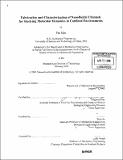Fabrication and characterization of nanofluidic channels for studying molecular dynamics in confined environments
Author(s)
Mao, Pan
DownloadFull printable version (9.460Mb)
Other Contributors
Massachusetts Institute of Technology. Dept. of Mechanical Engineering.
Advisor
Jongyoon Han and Peter So.
Terms of use
Metadata
Show full item recordAbstract
This thesis has characterized the applicability and limitation of PDMS micromolding and the substrate bonding techniques including both anodic (Si-glass) and thermal fusion (glass-glass) bonding, in fabricating sub-100-nm thick nanofluidic channels, which will be used for a controlled experimental study of molecular and fluidic transport in confined space. It is found that the fabrication of nanofluidic channels using PDMS substrate is generally limited to the thickness of -100 nm because of the softness of the materials. Also, the gas permeability of PDMS poses a significant challenge in the operation of the nanofluidic devices. We demonstrate that nanofluidic channels, as thin as 20 nm with high aspect ratio (more than 250:1, width to depth) on silicon substrate and 25 nm with aspect ratio of 2000 on glass substrate can be achieved with anodic bonding technique and direct glass-glass bonding technique, respectively. Scanning electron microscopy (SEM) measurement is used to prove that the channels are of good uniformity and there is no significant change of the depth of nanofluidic channels due to anodic bonding process and glass-glass bonding process. (cont.) In addition, we have demonstrated massively-parallel vertical nanofluidic filters, with fluidic conductance as large as standard microfluidic channels, by using a combination of deep reactive ion etching (DRIE) and anisotropic KOH etching followed by an oxidation step. The lateral nanofilter array device achieved separation of the mixture of X-DNA and Hind III digest of lambda DNA in half an hour by the mechanism of entropic trapping. The fabrication strategy for the nanofilter array device can be further optimized to achieve the uniform gap. These devices could be a key to the high-throughput nanofluidic sample-preparation microsystems.
Description
Thesis (S.M.)--Massachusetts Institute of Technology, Dept. of Mechanical Engineering, 2005. Includes bibliographical references (leaves 87-94).
Date issued
2005Department
Massachusetts Institute of Technology. Department of Mechanical EngineeringPublisher
Massachusetts Institute of Technology
Keywords
Mechanical Engineering.